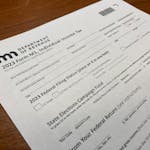The Twin Cities economy grew steadily in 2015, setting a pace that's better than average and keeping Minneapolis-St. Paul in its spot as the 13th-largest metropolitan economy in the U.S.
Gross domestic product from the 16-county area grew 2.7 percent last year, enough to stay just ahead of San Jose-Sunnyvale and Detroit and just outpacing the national average for growth, 2.5 percent, according to data released Tuesday by the U.S. Department of Commerce.
Finance, insurance, real estate and professional services led the way in Minneapolis, St. Paul and the suburbs, but the growth was broad-based. Construction, manufacturing, trade and health care also contributed to the rise in economic output.
Mankato, Rochester and St. Cloud each grew faster than the Twin Cities last year, according to the data, while Duluth was slammed by troubles in the iron ore industry.
The metropolitan area of Duluth-Superior, which includes all of St. Louis County, saw its economy contract 4 percent in 2015. The big decline was in the mining industry, and most other industries were flat.
Around the Midwest, Chicago posted its best growth rate in five years — 3.1 percent. The rest of Illinois, however, is struggling. Five metropolitan areas — Peoria, the Quad Cities, Decatur, Danville and Bloomington — saw their economies shrink.
Fargo and Grand Forks have cooled off a bit in the past three years, but Bismarck, which grew by 5.7 percent in 2015, remained one of the fastest-growing local economies in the U.S.
States in the region known for governors who are committed to low taxes — Kansas and Wisconsin — performed below average last year.
In Kansas, Manhattan was the most productive city with a 2.4 percent economic growth rate. Lawrence was flat, Topeka's economy shrank by 3.5 percent, and Kansas City, whose metro area stretches into Kansas, grew at a rate of 1.5 percent.
In Wisconsin, the economies of Madison, Eau Claire and Wausau grew solidly, but Milwaukee, Green Bay, Fond du Lac, Sheboygan, Janesville and La Crosse all grew at a rate below 2 percent. Racine's economy shrank.
The U.S. economy in 2015 favored places with deep pools of professional talent.
The industries that include professional, scientific and technical jobs, management of companies and consultancies — the work using computers to do complex tasks for businesses — contributed about a fourth of the economic growth in the country in 2015. That strength was echoed in the Twin Cities and Mankato, less so in St. Cloud, and not much at all in Rochester or Duluth.
Nationally, large cities to the south and west grew the fastest last year.
Los Angeles, Houston, San Francisco, San Jose and Denver all grew about 4 percent or better in 2015. San Jose-Sunnyvale-Santa Clara, the home of Silicon Valley, grew at a pace of 8.9 percent, the fastest of the top 20 metropolitan economies.
Meanwhile, New York, Washington, D.C., Boston, Baltimore and Detroit all grew about 2 percent or slower. Places like Chicago, Atlanta and Minneapolis-St. Paul hovered in the middle.
Adam Belz • 612-673-4405 Twitter: @adambelz




